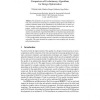Free Online Productivity Tools
i2Speak
i2Symbol
i2OCR
iTex2Img
iWeb2Print
iWeb2Shot
i2Type
iPdf2Split
iPdf2Merge
i2Bopomofo
i2Arabic
i2Style
i2Image
i2PDF
iLatex2Rtf
Sci2ools
PPSN
1998
Springer
1998
Springer
Comparison of Evolutionary Algorithms for Design Optimization
The production of specimen for microsystems or microcomponents is both, time and material-consuming. In a traditional design process the number of possible variations which can be considered is very limited. Thus, in micro-system technology computer-based design techniques become more and more important - similar to the development of microelectronics. In this paper we compare Evolutionary Algorithms based on Evolution Strategies and the extended Genetic Algorithm GLEAM for solving the design optimization problem. The reference problem is the design optimization of a 2-lens-system being part of a heterodyne receiver, a microoptical communication module. As this is a real world problem, the design must be as insensitive to fabrication tolerances as possible. The results obtained are compared to a more complex task: the robot path planning problem.
Design Optimization | Design Optimization Problem | Distributed And Parallel Computing | PPSN 1998 | Traditional Design Process |
| Added | 25 Aug 2010 |
| Updated | 25 Aug 2010 |
| Type | Conference |
| Year | 1998 |
| Where | PPSN |
| Authors | Wilfried Jakob, Martina Gorges-Schleuter, Ingo Sieber |
Comments (0)

